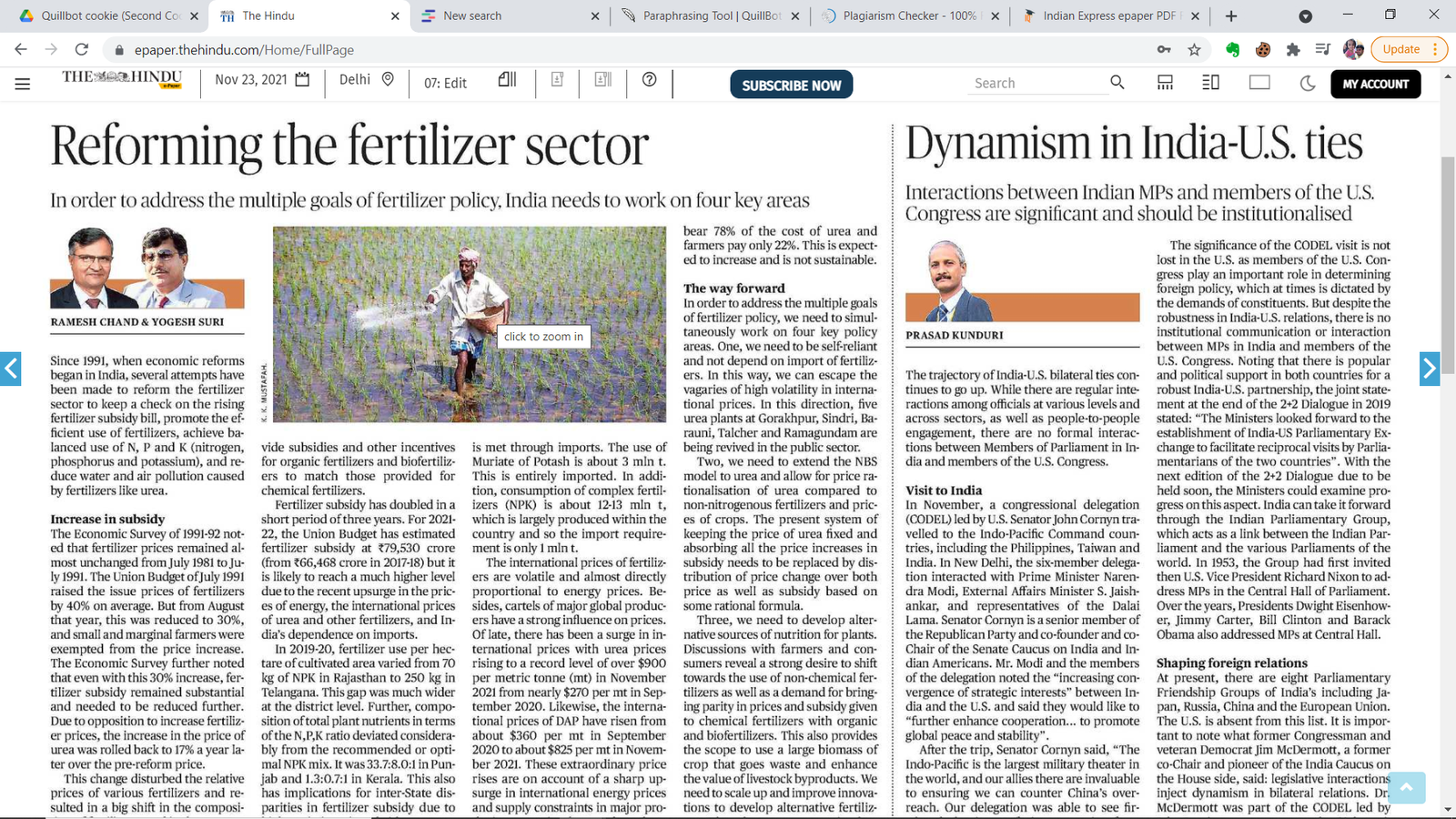
Prepare IAS Coaching
Current Affairs

Title : DYNAMISM IN INDIA-US TIES
Date : Nov 23, 2021
Description :
Based on a News Article published in the ‘The Hindu’ on 23rd November 2021 on Page Number 7
Useful for UPSC CSE Prelims and Mains (GS Paper II)
About India-US Relations:
- Bilateral relations between India and the United States have evolved into a "global strategic partnership," based on shared democratic values and growing convergence of interests on bilateral, regional, and global issues.
- Both countries issued a Declaration of Friendship in Delhi in 2015, as well as a Joint Strategic Vision for Asia-Pacific and the Indian Ocean Region.
- Deal on Civil-Nuclear Cooperation:
- In October 2008, a bilateral civil nuclear cooperation agreement was inked.
- Climate Change and Energy:
- The US Department of Energy (DOE) and the Government of India have established the Joint Clean Energy Research and Development Center (JCERDC) as a priority initiative under the PACE (Partnership to Advance Clean Energy).
- The JCERDC is designed to promote clean energy innovations by teams of scientists from India and the United States.
- At the Leaders Climate Summit 2021, the India-US Clean Energy Agenda 2030 Partnership was announced.
- Defence relations:
- With the signing of the 'New Framework for India-US Defense Relations' in 2005, the defence connection has emerged as a fundamental pillar of the India-US strategic alliance, which was subsequently revised for ten years in 2015.
- In the previous few years, India and the United States have signed several key defence agreements, as well as formalising the QUAD four-nation alliance (India, US, Japan and Australia).
- In the Indo-Pacific, the alliance is considered as a significant counter to China.
- The Malabar exercise in November 2020 was a watershed moment in Indo-US strategic relations; it was the first time in 13 years that all four QUAD countries joined together to deliver a strong message to China.
- From Djibouti in Africa to Guam in the Pacific, India now has access to American bases. It also has access to modern communication technology utilised in US military operations.
- India and the United States have four basic defence agreements:
- Geospatial Intelligence Basic Exchange and Cooperation Agreement (BECA).
- Agreement on the Security of Military Information in General (GSOMIA).
- Memorandum of Understanding on Logistics Exchange (LEMOA).
- Agreement on communication compatibility and security (COMCASA).
- In 2010, the India-US Counter-Terrorism Cooperation Initiative was signed to increase counter-terrorism cooperation, information sharing, and capacity building.
- In November 2019, a tri-services exercise called Tiger Triumph was held.
- Yudh Abhyas (Army); Vajra Prahar (Special Forces); RIMPAC; Red Flag are examples of bilateral and regional exercises.
- India's second largest trade partner and a major destination for India's products and services exports is the United States.
- During the 2020-21 year, the United States will overtake Mauritius as the second largest source of foreign direct investment into India.
- The previous US administration revoked India's special trade status (GSP withdrawal) and placed a number of restrictions; India replied by banning 28 US items.
- The current US administration has allowed all of the previous administration's prohibitions to expire.
- Science & Technology:
- ISRO and NASA are collaborating to develop the NASA-ISRO Synthetic Aperture Radar, a collaborative microwave remote sensing satellite for Earth observation (NISAR).
- Indian Diaspora: The Indian diaspora is becoming more visible in many aspects of life in the United States.
- For example, the current US Vice-President (Kamala Harris) has extensive ties to India.
- Latest Updates:
- For their first bilateral encounter in the United States, the Indian Prime Minister met the newly elected US President recently.
- Both leaders talked about a variety of topics, including Covid-19, climate change, and economic cooperation.
- Earlier on his visit to India, US Secretary of State John Kerry stated that the acts of India and the United States will determine the twenty-first century.
- The Meet's Highlights Include:
- Discussions focused on strengthening the Indo-US strategic alliance and global topics of mutual importance, such as threats to democracy, Afghanistan, and the Indo-Pacific region.
- One of the primary concerns discussed was Pakistan's position in Afghanistan, and there was a sense that it needed greater "careful monitoring."
- Both sides condemned the use of terrorist proxies and emphasised the significance of denying terrorist organisations logistical, financial, and military support that may be used to plan or carry out terrorist operations.
- They urged the Taliban to follow through on this and all other pledges made under Resolution 2593.
- When India was facing a wave of Covid-19 infections, the US government, companies located in the US, and the Indian diaspora were extremely supportive.
- In the fourth quarter of 2021, India will resume exports of surplus Covid-19 vaccines as part of the Vaccine Maitri initiative and to meet its obligation to the COVAX global pool.
- India brought up a number of problems concerning the Indian community in the United States, including access for Indian professionals and H-1B visas.
- Points of dispute include:
- The US considers India to be a high-tariff country, and it wants these tariffs decreased and a more predictable business environment.
- Despite the fact that growth is just 10% per year, many people believe the potential is far greater. Another point of controversy has been the H1B visa programme, which allows Indian skilled individuals to work in the United States.
- While the US President has made immigration a primary campaign issue in the past, it has not resulted in any significant impediments for Indians. However, in an election year in the United States, the discourse may get more heated.
- Despite the historic nuclear agreement, civil nuclear cooperation has stalled due to India's nuclear liability law and Westinghouse's insolvency. Reviving that discussion could aid in meeting India's energy requirements.
- Next Steps:
- While India can be an important part of America's Indo-Pacific strategy, the US may also assist India in countering China's aggression.
- India and the United States can be the two cornerstones of a rules-based world order in the current geopolitical context.
- Both parties must work together to ensure India's admission to the Nuclear Suppliers Group (NSG).
- In the next months, New Delhi must engage with Washington to ensure that the advantages of the 2+2 debate do not go solely to the other side.
- India will very certainly have to take a zigzag path to become a global force, balancing American demands, long-term friendship with Russia, and its own strategic needs in the region and beyond.
- The strong strategic cooperation is also built on the concept of "shared values" like as democracy, rule of law, religious liberty, and minority protection.
- The repeal of Article 370, as well as the new citizenship law and the NRC, put this "shared values" premise to the test.
- Because India claims that these issues are "internal to India," the Trump administration has refrained from publicly criticising India.
- Concerns about the United States' trade deficit with its economic partners across the world are at the centre of Mr. Trump's foreign policy plan.
- Despite the fact that India does not rank among the top ten in this category, there have been a series of spats between Washington and New Delhi over tariffs in certain sectors, which has thrown the bilateral balance off.
